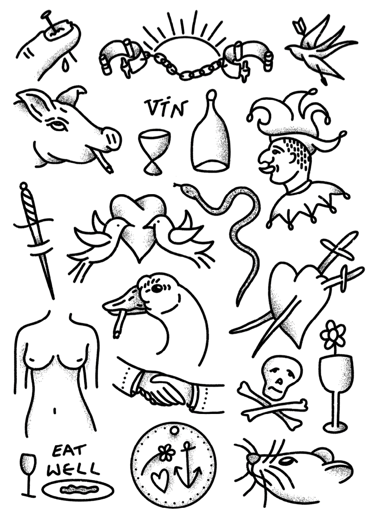Revealed: The history of 18th century convicts and their tattoos

19 Crimes has partnered with renowned tattoo historian, Dr Matt Lodder, to delve into the history of convict tattoos, as the brand launches its ’19th Cork’ campaign with a pop-up tattoo parlour, The Cl(INK).
Despite misconception throughout history that tattoos were merely the ‘mark of a criminal’, Matt’s research has shown that prisoners’ tattoos often held genuine sentimental value, from referencing their profession to reminding them of a lover, with symbols such as anchors and hearts featuring in the top 10 most common designs. Tattooing at a basic level has hardly changed in several thousand years, and the so-called ‘convict-tattoos’ from the 18th century are simply symbols of human emotions which resonate with all of us.
Delving into Digital Panopticon records, 19 Crimes has revealed the top 10 most popular tattoo designs found on convicts in the 18th century:
Anchor (15%)
Woman (14%)
Heart (8%)
Man (6%)
Star and Stars (6%)
Sun (4%)
Moon (4%)
Mermaid (4%)
Dots (3%)
Ring (3%)
The research, conducted by the wine brand who honours those transported to Australia having been convicted of 19 infractions, has been conducted ahead of the launch of The Cl(INK) – a pop-up tattoo parlour offering FREE tattoos from renowned tattoo artists. The Cl(INK) is part of 19 Crimes’ ’19th Cork’ campaign, during which a limited number of bottles of The Uprising and Red Wine will be released across the country which contain the so far unreleased 19th crime printed cork. Customers who manage to track down one of these corks will win a cash prize, and visitors to The Cl(INK) also have the opportunity to unveil a clue as to the location of two 19th cork bottles in Shoreditch, if they’re brave enough to pick a mystery 19th tattoo at the pop-up.
Visitors will choose from a list of 19 designs from flash sheets that have been produced by a carefully selected team of tattoo artists in collaboration with Dr Matt Lodder and that are authentically inspired both by the tattoos on the skin of convicts in the 18th century, and the 18th-century-Britain heritage of the 19 Crimes brand. Guests also have the option to book in for a modern interpretation of the traditional stick and poke method, providing an added taste of what an 18th century tattoo experience would have been like.
According to the findings, 80% of incarcerated men and women would have been decorated with tattoos by the early 20th century. Research has also revealed the negative narrative on tattoos at the time, unveiling quotes from prominent figures such as Italian criminologist Cesare Lombroso, who claimed in 1887 that tattoos are the “stigmata of the criminal man”, whilst 20th century modernist, Adolf Loos, noted that “the modern man who tattoos himself is either a criminal or a degenerate”.
Throughout the 18th & 19th centuries, the British and American navies had been recording tattoo habits amongst enlisted men, in part to allow them to be identified if they deserted and went on the run, and in Britain, prison records and other penal bureaucracy began to record tattooing and other identifying marks on inmates systematically in order to aid identification.
New research by the Universities of Liverpool, Sheffield, Sussex, Oxford and Tasmania has compiled these records into a database called the Digital Panopticon, which lists all the tattoos on British convicts between 1780 and 1925, including those shipped to Australia. While it should be obvious that whilst there were a lot of tattoos in prison, there was also a lot of tattooing happening elsewhere which simply wasn’t recorded in the same way. The link between tattooing and crime is thus an artefact of an extraordinarily flawed historical research method, and not necessarily indicative of any deeper historical truth.
Dr Matt Lodder, Senior Lecturer at the University of Essex, said “I am so excited to be working with 19 Crimes on this project, which takes the intimate human stories of the men and women who were transported to the other side of the world – and the marks which many of their peers thought set them apart from the mainstream – and uses them as a way to think about what brings people together, and what connects us in the present to our ancestors and fellow human beings from the past. Through their tattoos, these men and woman are revealed to be more than simply ‘criminals’, but human beings with rich inner lives, social connections, and deep, profound emotions familiar to us today.”
Sarah Featherstone, Brand Manager at 19 Crimes, said “The world of tattooing is such a perfect fit for 19 Crimes, and we are honoured to have been able to get Dr Matt Lodder and such a talented collection of tattoo artists on board with this project to promote the 19th Cork campaign! To be able to bring to life the story that inspired the 19 Crimes brand whilst offering our customers a unique experience and free tattoos in the heart of Shoreditch is so exciting, and we can’t wait to meet everyone at the pop-up on the 11th and 12th September”




